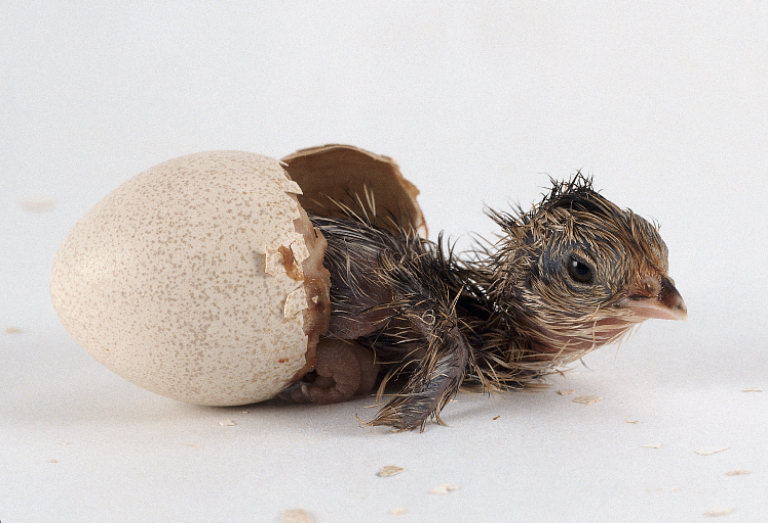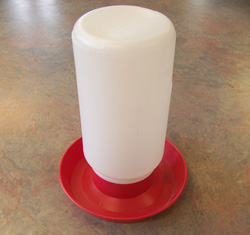

Set Everything Up
Make sure you have your brooder set up before you bring your chicks home. Scatter the bedding into the brooder, hang the lamp (an adjustable height cord is helpful) and set up the thermometer. You want the bedding under the heat lamp to read 95 degrees F. Fill the waterers and feeders and set them so that they are not entirely under the lamp or entirely at the edges, but where the chicks can eat comfortably and not get either chilled or overheated.
As Soon As They Get Home
When your chicks first arrive home, whether from the feed store or via the shipping process from a far-away hatchery, they are probably a bit stressed. Gently remove them from the box and dip their beaks in water as you set them into the brooder. Let them acclimate to their new home.
Watch your chicks to see if they are comfortable. Temperature is critical in the first few days and weeks. Think of the heat lamp as their replacement mother, because that's essentially what it is. Without the heat lamp they will die quickly. If the chicks huddle under the lamp, they may be too cold, so lower the lamp. If they scatter to the edges, they may be too hot, so you'll need to raise the lamp. Throughout the first week or so you'll need to keep a close eye on this.
Preventing Problems
"Pasting up" is a condition where feces builds up on the chicks' vents, blocking exit of more feces. This can kill young chicks. Causes include stress from shipping and getting chilled. Check your birds' rear ends every day for pasting up and use a warm wet cloth to remove the feces. If really bad, you might need to cut the downy feathers around the vent off with scissors.
If you have children, be careful of over handling. If chicks are pasting up, make the kids leave them alone until the problem is gone. Pasting up chicks are stressed chicks. Curious dogs are also a risk to baby chicks. Put a screen door or other cover over the brooder to keep the chicks safe.
They will get their waterer's and feeders filthy with bedding. Clean
it up as much as you can. You don't want them ingesting large quantities
of bedding. Change their bedding about once a week. Or sooner if needed.
Lowering Temperature
Each week, lower the temperature by 5 degrees until the temperature
reaches outdoor temperatures. So for the first week, keep them at 95
degrees F. The second week: 90 degrees F. Third week: 85 degrees F.
Adjust this as necessary so that they are comfortable - not huddling
under the lamp (too cold) or scattering to the edges (too hot)." This also depends on the time of year you get your chicks, do not take away the heat lamp until the are fully feathered and can regulate there own heat.
Outside Time
Starting at around 2-3 weeks of age, if the temperatures are warm (over 65 degrees F), you can bring them outside for short periods of sun and foraging. Make sure to add grit to their feed if they will be eating anything other than chicken feed. Grit is small stones that chickens keep in their crop to help them grind up bugs, grass and other food.
Moving the Chicks to the Coop
By 4-5 weeks of age the chicks are ready to move to their main coop full-time, or if the brooder is in the main coop, for the heat lamp and brooder to be removed. When you move them, keep them closed in the coop for a day or two (rather than letting them free-range) so that they learn that the coop is "home." Once there, follow basic chicken care to keep them growing strong! They will start laying eggs at around four to six months of age.
Brooder Guard or Area
A brooder area
is, simply put, a draft-free place where you will keep your chicks.
Feed and farm supply stores sell large, oval galvanized tubs for this
purpose, and you can buy specialized brooders complete with heat, but a
brooder can also be made of cardboard, a plastic tub, a kiddie pool, or
anything else you can dream up. Cardboard bins from your local vegetable/fruit store work amazing as well.
One caution: chicks have a habit of finding any little crevice or opening in the brooder and getting out. You'd think they could find their way back in, but when they're very young, they can't. You'll hear the loud cheeps of a lost chick anytime one gets out, but if they can't get back in, they can eventually die of stress, starvation, or thirst.
Brooder size: 2 square feet of space per chick.
Brooder Heat Lamp
Unless you have a complete brooder, you'll need a 250-watt heat lamp to keep the chicks warm. The area under the lamps should be 95 degrees F the first week, decreasing by 5 degrees per week until the chicks are fully feathered out (about 6 weeks of age) and/or you've reached the ambient temperature outdoors at night.
Have a backup, too. Chicks will die if they get too cold, so a spare light bulb will help ensure they never freeze to death. The light bulb needs to be housed in a proper lamp housing with a metal guard to prevent it from catching the bedding on fire if it should fall. Making sure it's height-adjustable is helpful, too.
One 250-watt heat lamp will warm 75 chicks at 50 degrees F ambient temperature.
Chick Waterer's
I
like to use little giant waterers' for chicks for the first week or two.
You'll find as they grow, you'll refill it more and more often. I use three per 25 chicks and refill every 2
or 3 days. Or as needed.
Once they're a bit bigger, they can handle a gallon waterer or more. After about two weeks, I just move to a 5-gallon waterer like I use for my grown layers.
Set the waterers up out of the shavings on a piece of wood/brick or other makeshift stand as they grow, or you'll be picking shavings out of the water several times a day.
Chick Feeders
It's worth investing in special chick-sized feeders. I like the feeders with holes that they peck through for the first week or two, like the ones shown in the photo. You'll save enough money in wasted feed with the chick feeders that it will pay for their cost. They're designed so that the chicks can't get into and poop in the feed or tip it over. Allow free access to feed at all times.
The very first day, I spread some feed on a piece of cardboard and tap it. They immediately find the feed and the sound of beaks tapping on cardboard leads other chicks to the sound.
After about a week or two, I move to a tube-style feeder. Leave the chick feeders and new feeder out together for a day or so, to make sure they find the new food.
Bedding
Baby chicks need bedding just like older hens. Pine shavings are best as straw or hay are the wrong scale for them. They will get lost! Others start chicks on newspaper covered with hardware cloth. Never start chicks on newspaper alone, because it's too slippery. They can develop a condition called spraddle legs from being started on newspaper.
Feed
Use a high-quality feed, usually called "chick starter." Different brands of feed will have you transition to grower at different ages - some at 6 weeks of age and some as late as 6 months of age. Follow the recommendations of your feed manufacturer.
Medicated or not? It's up to you. If you have your chicks vaccinated for coccidiosis at the hatchery, do not feed medicated feed. If they're unvaccinated, you might want to provide them with medicated feed for extra protection.
Supplements
Here are some of the "extras":
- Gro Gel Plus: a gel that you feed to new hatchlings. Helps them find the feed and gets them off to a good start. Not necessary, but nice.
- Quik Chik (or another brand): a vitamin and electrolyte powder you use in their water.
- Diatomaceous earth: use food-grade only. Can be sprinkled in their feed to deter diseases, and when they're older you can sprinkle it in the coop (wear a respirator!) to kill mites.
- Grit: after the first week, if the birds have any access to bugs or worms, make sure they also have a source of grit, which helps them digest "real" food. Just some sand or dirt is fine, or you can buy grit at a feed or farm store.


